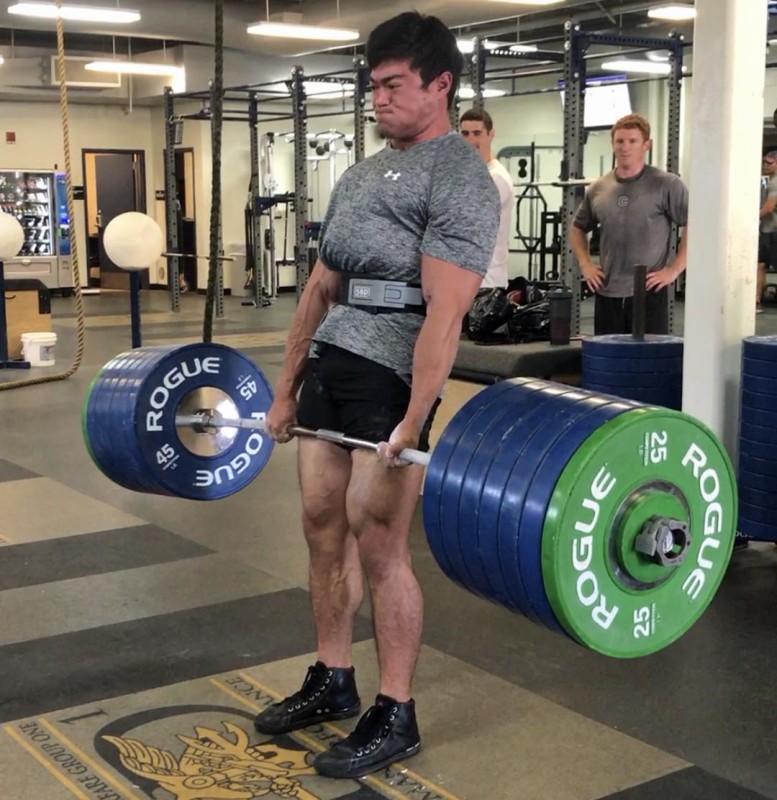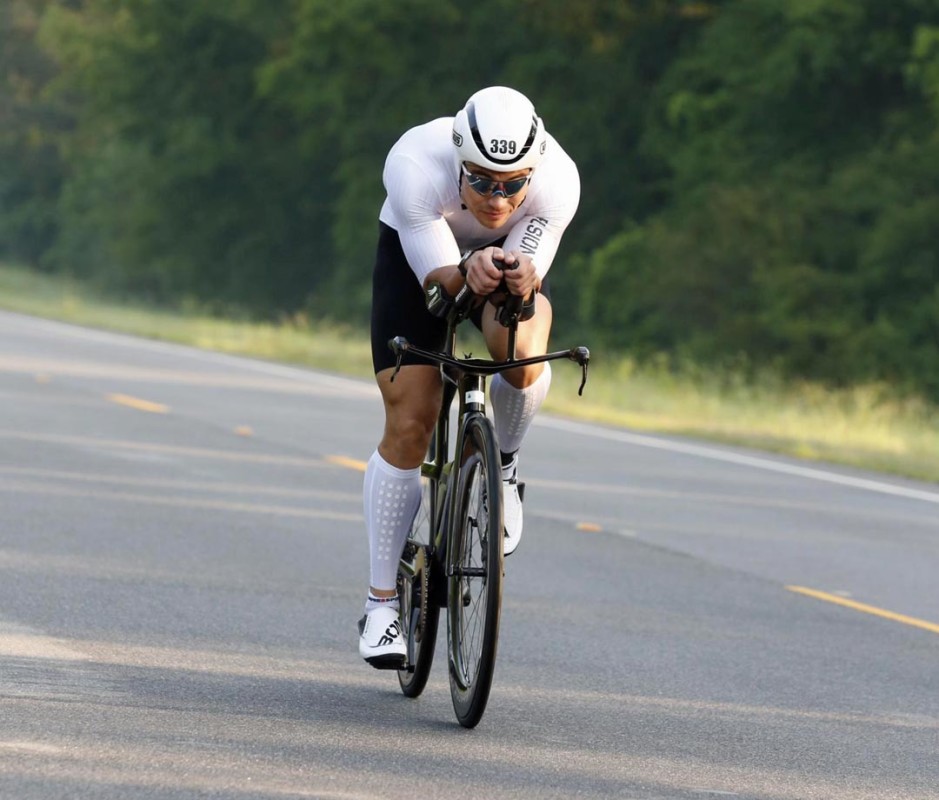Being a fit guy has always meant asking whether you’ll be an endurance guy, knocking off fast 5Ks and maybe biking centuries, or a strong guy, racking up big numbers on the squat, deadlift, and bench.
In the past few years, though, men have been asking, “Why not both?”
The answer has been the emergence of the hybrid athlete: Freaky strong with freaky stamina. Men like Ryan Hall, who retired from being America’s most decorated marathon runner and now pairs long runs with 500-pound yoke carries. Or Ross Edgley, the British long-distance swimmer who alternates between lake-length swims and wrangling dumbbells bigger than his head. Or Scottish hybrid athlete Fergus Crawley, who squatted 500 pounds before knocking off a 4:58 mile while weighing more than 200 pounds.
Related: Biggest Fitness Trends of 2024 and Worst Fads to Leave Behind
Add another name to this list of superhumans: Blaine Lints. The Ph.D. candidate in kinesiology at the University of South Carolina has built an athletic resume that would take more than a lifetime in just 30 years. At 16, he ran 100 miles in 18 hours, 26 minutes and 113.25 miles in 24 hours. He became a Navy SEAL at 18 and eventually broke the SEAL deadlift record, hefting 640 pounds.
That same year, 2018, Lints transitioned to a new, hybrid training mode to tackle a 100-mile race while maintaining that deadlift strength.
“I lacked the confidence and specific fitness to sustain moderately high work rates for such long durations,” he says. He enlisted the help of Alex Viada, author of The Hybrid Athlete, and one of the pioneers of the concept. The result? He completed the 100-mile Hawaii Kai Ultra Run XTreme—as the only 100-mile finisher at the event—while maintaining the lion’s share of his strength.
Seeking a new challenge as a hybrid athlete, Lints turned to Ironman-distance triathlons in 2022. That’s a 2.4-mile swim, 112-mile bike ride, and 26.2-mile run. He mostly recently finished 4th overall at Ironman Chattanooga, winning his age group, taking 32 minutes off his time from the year before, and qualifying to go pro in the three-sport discipline.
Even if you aren’t hoping to carry 140 pounds to the top of a mountain like Ryan Hall, or gun for an Ironman podium like Lints, hybrid training offers regular guys engine-building endurance to set a half marathon PR, while building shirt-filling muscle mass.
Sports scientists like Lints have discovered—and demonstrated—that many of our old biases against building strength and stamina at the same time don’t hold up to scrutiny. In a 2021 review of 43 studies on hybrid training published in Sports Medicine, scientists concluded that while we’ve long believed that aerobic exercise blunts our ability to get big and strong, “concurrent aerobic and strength training does not interfere with the development of maximal strength and muscle hypertrophy compared with strength training alone.”
Related: Jason Momoa Shares His 'Game-Changing' Kettlebell Workout to Bulk Up
Training strength and endurance does sound a bit like CrossFit, but CrossFit workouts, in general, address multiple components of fitness in a single, high-intensity session. Those workouts definitely get you fit, but they don’t address absolute strength (like your 1RM) and endurance in the way that hybrid training does by programming workouts dedicated to each.
What Is Hybrid Training?
First, understand that hybrid training is not simply stacking an endurance program on top of a strength cycle. The combined stress of two full programs adds up, leading to injury, burnout, or both, says Lints.
Training properly for two goals “is like putting a puzzle together, where you’re trying to get the most out of your time in a way that’s going to benefit all the things you want to improve,” he says.
If you were doing a normal marathon training program, for example, you might run 50 to 100 miles per week—running almost every day. But running that much takes up a lot of time and includes a lot of mechanical stress via impact, Lints says, providing cardiovascular benefit, but also beating up your legs—not great if you also want to do heavy squats a few times each week.
“In hybrid training, you may only need a total volume of running of 20-40 miles per week while substituting additional aerobic training through lower impact aerobic exercises,” he says. So instead of getting all your cardio by pounding the pavement, you might spend some time on the bike, rower, elliptical, or stair climber.
At the 2023 Ironman 70.3 Chattanooga, Lints recorded the fastest bike split by 3 minutes.
Courtesy Blaine Lints
The strength training workouts will also be lower-volume than they would be if you were only focused on strength. These workouts will focus on compound exercises, like squats, deadlifts, benches, and rows, and skip single-joint accessory moves like curls and leg extensions. This saves time and energy.
Hybrid Training for Running and Strength
Here’s a sample from Lints of what a hybrid program might look like for a guy who has some experience in both endurance training and strength, and hopes to train for a marathon while building strength:
Monday
Strength: Heavy, lower-volume upper body strength training session, focused on a compound movement that’s a priority.
Cardio: Interval running, accumulating 10-40 minutes of “hard” (around 4-out-of-5 effort) work—this could be 5 intervals of 8 minutes each, resting 2 minutes between sets, or shorter intervals like 10 rounds of 200-400 meters, resting the same amount.
Tuesday
Strength: Heavy, lower-volume leg day, emphasizing the athlete’s primary compound leg movement.
Cardio: Then 20-40 minutes of low-intensity cardio—but not running. This could be biking, the air bike, or another cardio mode that can be done easily.
Wednesday
Strength: Rest.
Cardio: Threshold running day at marathon pace. This could include 3-4 intervals of two miles each, 6-8 intervals of one mile each, or 4-5 intervals of 10 minutes each, each with 1-2 minutes rest between intervals.
Thursday
Strength: Higher-volume upper-body strength day.
Cardio: Rest.
Friday
Strength: Higher-volume lower-body lift.
Cardio: 20-40 minutes of low-intensity cardio. This could be running, but it could also be biking, the air bike, or another cardio mode that can be done easily.
Saturday
Strength: Rest.
Cardio: Long run. Lints says that in a hybrid program, you likely won’t have the gas for the same length of long run as in a traditional marathon program, but athletes should eventually build up to 16 miles.
Sunday
Total rest.
Blaine Lints's Favorite Hybrid Training Tips
Give Yourself More Time Than You Would for a Single Goal
“Things may move along at a much slower rate than they would if two goals weren’t combined,” Lints says. Guys don’t always take this into account, which can be frustrating.
So if you’re a lifting-focused guy who would like to join friends in a longer running race later in the year—or a running-focused guy who wants to try a powerlifting competition with gym buddies—remember that the program your one-goal friends might be undertaking may be too short for you while you’re trying to maintain or grow the other aspect of your fitness. Instead of a three- or four-month buildup to a half marathon, for instance, you might need five or six.

Lints deadlifting 640 pounds to set the Navy SEAL training record.
Courtesy Blaine Lints
The good news, Lints says, is that early on, your weaker side will improve without adding a ton of extra time—which can be seriously motivating.
Track How Your Body’s Feeling
Adding new types of training to your regimen uses up more energy, and adds stress to both your body and mind. “You also have to consider what kind of stress you’re accumulating in your daily life, whether that’s personal stress or professional stress.”
Too much stress can push you closer to breaking down, or suffering from overtraining syndrome, a condition that can result in low mood, disrupted sleep, and hormonal changes that won’t let you perform or progress.
To keep yourself from entering this unpleasant, potentially dangerous state, Lints suggests tracking how your body responds to your training—but says it doesn’t need to be complicated. These four variables are simple to track, and only require a pen, paper, and heart rate monitor:
• Heart Rate at Different Training Intensities: When you’re starting to overdo it, your heart rate may be higher at a speed that’s usually easy. Keep track of your baseline heart rate—for instance, your easier cardio sessions may be at 130-140 bpm. If you’re running that same pace, but your heart rate is significantly higher, back off on your training volume.
• Heart Rate Recovery (HRR): This is a measure of how quickly your heart rate can come back to baseline after a bout of exercise. First, test your HRR for a baseline reading with a hard workout. Check your heart rate immediately after your last big effort. And then check it again after one minute. So if you finished the workout at 180 bpm, and a minute later it’s at 120 bpm, your HRR (180-120) is 60 at base. In the future, test it again under the exact same conditions. Perform the same workout, and rest in the same position while timing. If your HRR is lower, you may be overdoing it.
• Rate of Perceived Exertion (RPE): This, Lints says, is the marker he uses most often to keep track of his progress and recovery needs. RPE is a rating that you assign of how much effort you’re giving on a scale of 1 to 10, with 10 being flat-out sprinting. RPE is subjective, so it can take time to understand your effort levels and limits. But once an athlete is comfortable using the scale, they know their body is telling them something when a workout intensity that usually feels like a 6 suddenly feels like an 8 or 9.
• Mood: In addition to tracking your pace, time, weight lifted, and all the other quantitative measures, also include how workouts felt and what your mood was like. t only will this keep how you’re feeling top of mind, but you can look back at similar workouts to see if you felt better or worse.
To Rebound From Overtraining, Eat, Sleep, and Dial Back Workouts
When any of these variables gets out of whack, Lints says, you may be teetering on the edge of overdoing it in training. Start, he says, by focusing on sleep.
“When I was in high school, and even during my time in the SEALs, I often prioritized training over sleep,” he says. “With my current experience and understanding of training and physiology, I won’t cut my sleep to anything less than 6 hours, and I aim to get at least 7-8 hours every night.”
Next, he says, make sure you’re consuming sufficient calories to maintain your body weight. Training for two goals and dealing with all the rest of life’s challenges are already stressors. Piling a weight loss program—or even a weight loss level of calories—on top of that can push you towards breaking down.
Finally, he says, pare down slightly on your training until you’re feeling strong again.
“During these times, I shy away from performing high intensity work, and have a reduction in total volume,” he says. Dropping 10-20 percent of your total training volume can help you get back to your normal level of recovery.

